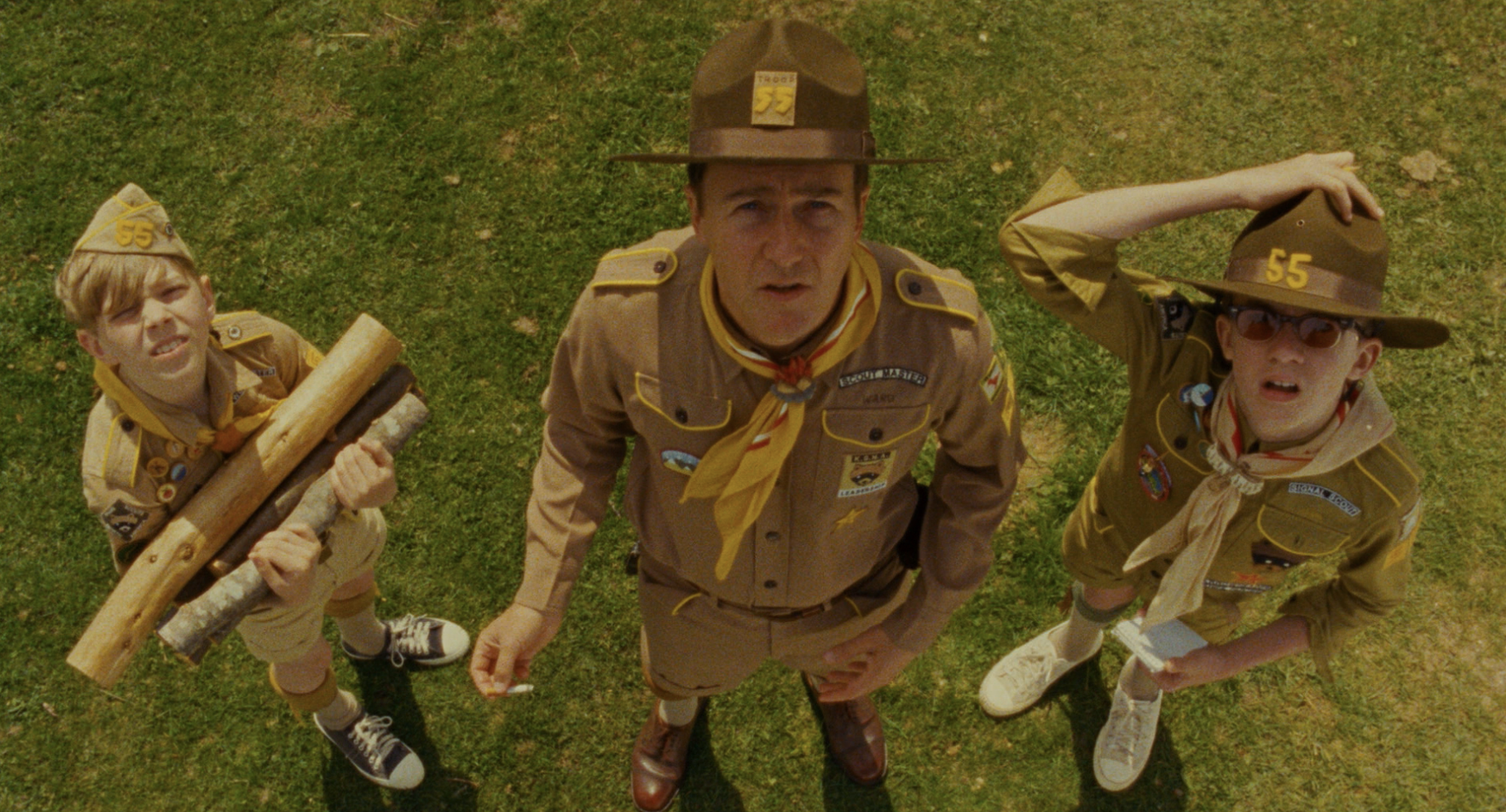Wes Anderson's Wes Anderson
I first watched The Royal Tenenbaums when I was in sixth grade, introducing me to Ravel’s “String Quartet” and initiating a lifelong love of classical music. Needless to say, much of it went over my head. Many will have been acquainted with Anderson’s work through The Grand Budapest Hotel, which received unprecedented laurels at this year’s Golden Globes and Academy Awards. Though aside from Oscar nominations for Best Original Screenplay (The Royal Tenenbaums in 2001 and Moonrise Kindgom in 2012), Anderson has received very few mainstream awards despite performing well critically and having generally positive popular opinion.
Wes Anderson is somewhat of a maverick in today’s filmmaking. If the mark of a successful director is that people are able to identify his or her stylistic patterns, without a necessarily deep knowledge of filmmaking, then Wes Anderson has succeeded astronomically. Because of his dysfunctional families, social outcasts, bright colors, and indie music, Wes Anderson’s name has become synonymous with hipster nostalgia and visions of prepubescent couples dancing to French chansons, establishing him as a central figure in independent cinema. However, these seemingly arbitrary aesthetic choices accomplish much more than being quirky or pretty. Careful consideration given to detailed sets, meticulous shots, and flamboyant dialogue supports an unusual hypothesis: that Wes Anderson’s films do with “academic” or otherwise prestigious genres of storytelling what drag shows do with gender—expose their performative aspects and deconstruct them.
O R they?
Anderson’s most recent film, The Grand Budapest Hotel, which is related through a frame narrative by a famed author a la Citizen Kane, is not the only film to support this possibility. Rushmore is framed as a theatrical production, opening and closing with the drawing of stage curtains to reflect the ambitious thespian aspirations of its protagonist, Max Fischer. The Royal Tenenbaums similarly contains a playwright character, Margot Tennenbaum, and is divided into chapters the way one might divide a book – as is The Grand Budapest Hotel. The Life Aquatic with Steve Zissou opens with the unveiling of a new documentary by the titular character at a film festival while The Darjeeling Limitedbegins with a chase scene echoing the romantic exoticism of World War II espionage flicks. The stuffy, didactic writing employed in The Life Aquatic again appears in Moonrise Kingdom as an anonymous narrator foreshadows the impending arrival of a violent hurricane throughout the narrative.
A fascination with prestige might explain Anderson’s use of formal conventions commonly found in other media and other genres of filmmaking, especially those that connote importance, such as the prominence of book covers in The Royal Tenenbaums or the disorienting editing and awkward dialogue of his short, Hotel Chevalier - the pseudo-cosmopolitanism of his films is a playful, self-conscious jab at the stereotypes of foreign cinema. The songs of The Life Aquatic are in Portuguese, and the press conference that opens the film is held in French; the maids at the Grand Budapest also speak French, and the crew of the Darjeeling Limited speak Hindi. If it were not for his ability to do so subtly, one might argue Anderson shoots himself in the foot by distancing himself from high art, since his own films are also frequently highbrow in their intentions (one could argue The Grand Budapest Hotel becomes the very kind of storytelling it satirizes). However, those who call his films “pretentious” may not realize that they are in agreement with the filmmaker, that cinema has yet to move beyond the aesthetics associated with importance and prestige - a kind of anxiety of influence.
The Rebel Prep
Uniforms also play an important role in defining Wes Anderson’s visual style, whether they are the red caps of Steve Zissou’s aquatic teammates, the yellow jumpers in Bottle Rocket, or the jogging outfits of Richie Tenenbaum and his children, Ari and Uzi. We see uniforms used in the dress code of Rushmore Academy, the Khakhi Scouts, the staff of the Grand Budapest, and the inmates and soldiers of Zubrowska. Aside from lumping people together into categories like they are Ikea products, the recurrence of uniforms calls into question the nature of group identity and belies a suspicion of conformity. Max Fischer, Sam Shakusky, Zero, and Steve Zissou are all nonconformists, as are many of his characters, and are faced with having to sublimate their frustrated ambitions through role-play, elopement, and revenge. Likewise, the cinematography further emphasizes an obsession with organization. The centered shots and collected movements of the camera contrast with the disorderly lives of its characters, though occasionally paralleling their obsessiveness, and are emblematic as false signifiers of order in a world of chaos.
To that point, Rushmore encapsulates the spirit of Wes Anderson’s style: a rebel in preppy clothes. Inspired by Anderson’s enrollment at St. John’s School in Houston, Rushmore relates the folly of Max Fischer, a student of the prestigious Rushmore Academy who seems to have everything in order, as he tries to win the heart of a preschool teacher, Miss Cross. “What’s the secret Max?” his later acquaintance and self-made business tycoon Harold Blum asks. Yet, the influence Max wields over Rushmore Academy is due to his extracurricular activities and intellectual cunning, not his academic performance – in reality, Max is one of the worst students Rushmore has. When asked where he is applying to college by Miss Cross, he says Oxford and the Sorbonne (Harvard is his safety school). He knows how to play the part. Nevertheless, at the core of Max’s interactions is a social vulnerability he attempts to hide from others, which escalates from cute to highly problematic as he begins to make advances on the much older Miss Cross.
Unlike those of his later films, the palette of Rushmore is remarkably subdued, and the thematic material sobering. The film is unique in that it is Anderson’s first to be filmed in a clearly stylized manner. Its predecessor, Bottle Rocket, which is shot in a slightly more realist manner, is visually unrecognizable as a work of the director and its successor, The Royal Tenenbaums, is arguably the pinnacle of Anderson’s quintessentially baroque visual language. In a way, Max’s infatuation with an older woman mirrors Anderson’s infatuation with older styles of filmmaking. And just as Max attempts to pass as a mature gentleman, Anderson’s films mimic the experimental ventures of his French New Wave predecessors. Long tracking shots, shifting aspect ratios, and slow motion combine to create the cinematic voice of an adolescent. Like Max, Anderson seeks to overturn the establishment by eating at it from the inside out - exploiting its various loopholes and contradictions.
Needle in the Hay
Much discussion has been devoted to how Anderson engages with earlier cinematic tropes, but not enough to what it means or why it is appealing. Given his preoccupation with genre, it may come as a surprise to some that he does not satirize the conventions of science fiction or adventure filmmaking. However, such a reaction neglects the self-deprecation at the center of Anderson’s world. Sad attempts to beautify unadorned surfaces such as the Christmas lights that decorate the railings of Zissou’s boat as well as the fences surrounding Max’s neighborhood arouse pity in the viewer. The camp effect of Anderson’s films is unlike that of films by John Waters, because the exaggeration is insincere; where other films might ask us to suspend disbelief, his films ask us to consider emotionally real problems.
When appreciating Wes Anderson’s films, it is not enough simply to note that all of them have precocious children and a recurring cast, or even to note the influence of directors Francois Truffaut and Satyajit Ray; it is necessary to explain why these patterns appear and why these directors are honored, and understand how these elements contribute to a film’s message. Anderson’s signature timelessness and expressiveness return us to the mindset of a child looking at the sinister world of adults, a world of people put into roles they do not want to occupy but nevertheless themselves have created. At its heart, the filmography of Wes Anderson is about characters that defy categorization. It would be appropriate to say the same about his movies.










